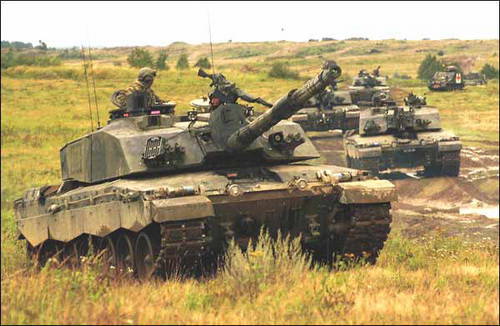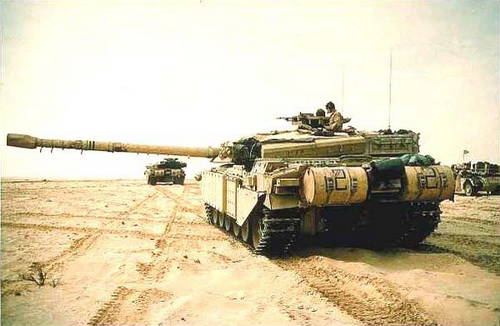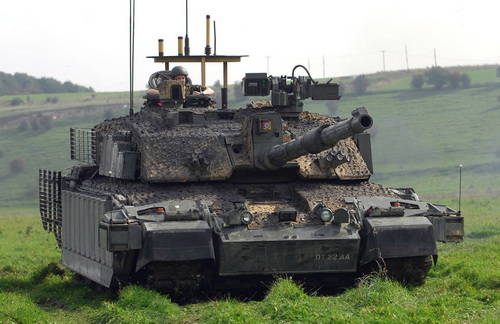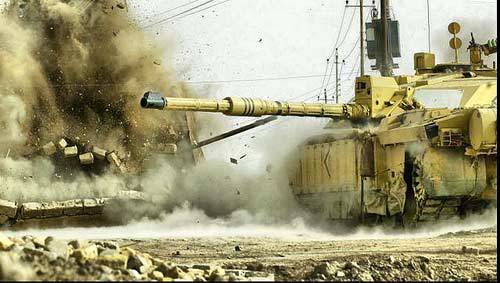Western main battle tanks (part of 4) - Challenger-2
Under these conditions, the British government decided to announce a tender for replacing the Chieftain tanks in the English army. At this point in England, Vickers had no competitors in tank building, so foreign companies were allowed to enter the competition. The Germans offered “Leopard-2”, the Americans - “Abrams” М1А1, the Brazilians offered the tank ЕЕ-Т1 “Osorio”, the perspective French tank “Leclerc” was also considered.
The choice of any non-British machine threatened the collapse of the entire British tank building, the financial crash of the Vickers, as well as many of the company's subcontractors, as in the 1988 year, the production of the Challengers for the British army came to an end, and export orders for the tank were not expected. The adoption by the army of a foreign tank could have the hardest impact on all British tank building for the next 20 — 30 years. As a result of this, the British had a choice not only and not so much tactical and technical, as political and economic. The result of this choice was clear to everyone in advance.

The competition's favorite was the Challenger 2 tank produced by Vickers, while this tank existed only on paper in 1987. The project presentation was held in 1987 year. The main emphasis was placed on the manufacture of a new tower, guns and fire control system (FCS). Actually, the project provided for the correction of everything that was “under-modernized” on the “Challenger” in comparison with “Chieftain”. At the beginning of 1988, Vickers built 8 pilot towers at their own expense, the first of which was ready in the fall of 1988. And in December, the British Defense Ministry signed a contract for the production and conduct of demonstration tests of tank prototypes. A total of 9 experimental Challenger 2 tanks and 2 turrets were made, which were shot on ballistic tests. The tests began in 1989 year. And the final choice of the winner of the “competition” in 1991 - the tank “Challenger-2” - miraculously coincided with the end of its demonstration tests. The "highlight" of the project was its tower of new design, when designing the experts from Vikkres took into account the experience of developing the Vikkers Mk.7 tank tower and the EE-T1 Brazilian tank, to which the British manufactured.
The turret turned out to be simpler than the Challenger turret, and it has less visibility in the radar range. With the advent of ground-based radar reconnaissance aircraft in the armies of the world, tank designers began to pay more attention to reducing their visibility. A new 120-mm rifled L30 cannon with 55 barrels of caliber has been installed in the turret. In order to extend the service life of the gun, the barrel bore is chromed. The diameters of the trunnions and nests under them were increased, which had a positive effect on the trunk oscillations in elevation and azimuth and led to an increase in accuracy. Gun ammunition consists of separate charge 50 shots. Shells and charges are stored in separated packs. In the process of designing the tower, it was planned to install an automatic loader in it, but for a number of reasons (design complexity, vulnerability in battle, reduced reliability), the idea of installing it was still abandoned.

Drives of pointing the gun and turning the turret are completely electric, the angles of pointing the gun in the vertical plane are from -10 to + 20 degrees. The tank cannon is stabilized in two planes. To the left of the cannon, an 7,62-mm machine gun paired with it is mounted, another one is mounted on the turret at the loader's hatch, and the machine-gun ammunition makes 4000 shots. In front of the turret installed on 5 smoke grenade launchers. Inside the tower to the right of the gun is the gunner and the commander (the workplace of the tank commander is somewhat elevated above the gunner's place), the loader is located to the left of the gun. Instrumentation and electronic equipment of the tower in comparison with the "Challenger" was completely replaced. For the first time, an English tank received the Mil Std 1553 data bus, a standard NATO interface used in combat helicopters. The military believe that the transition to a single interface standard and equipping them with various combat systems will significantly increase the speed of information exchange between all the equipment involved in the hostilities.
Combined in two planes stabilized gunner sight created by Barr & Stroude in collaboration with the French SAGEM. The daytime optical channel of the sight has 2 approximations - 4-or 10-multiple, nighttime has 4-or 11,4-multiple approximation. The laser range finder is integrated into the sight. The TOGS-2 thermal imager, created on the basis of the TOGS thermal imager of the Challenger tank, is used as the sensitive element for the night channel. The sensing element is mounted above the barrel of the gun and is covered with a special armored sash, which opens only when the night channel is activated. As an auxiliary to the tank used telescopic sight NANOQUEST L30.
The tank commander has at his disposal a stabilized panoramic periscope sight SFIM, which is a simplified sight "Leclerc" (in the English version there is no night channel). The optical channel of the sight has 2 approximations - 3- or 8 -fold. In the field of view of this sight receives information about the course of the tank and its location. For the implementation of the fighting at night there is a video monitor, which receives an image from the night channel of the gunner’s sight. Also around the perimeter of the commander's turret installed 8 observation devices that provide a circular field of view. The control system of the armament of the tank was created by the Canadian firm CDC and is a modernized version of the computer of the American tank МХNUMXА1 "Abrams".

Using the SLA, the tank commander can independently fire the gun and fire, mark the detected targets, or fully transfer control of the gun to the gunner, while conducting an independent search for new targets. A typical cycle from aiming to hitting a target takes only 8 seconds. For example, when testing prototypes, well-trained crews could hit 8 targets in 42 seconds. The body of the Challenger 2 tank is practically no different from its predecessor, but its filling has undergone modernization, although not as dramatic as the tank tower. The body of the combat vehicle, as well as its tower and screens, is made of advanced armor "chobhem", which has an increased, in comparison with the armor, "Challenger", projectile resistance. In front of the housing "Challenger-2" are nodes that allow you to hang on him dozer equipment.
Initially, the designers wanted to equip the tank with a 1500-strong diesel, but the military found it possible to leave the old 1200-strong engine. By the way, of all modern MBTs of Western countries, the English tank has the weakest engine that accelerates a car weighing tons in 62,5 up to speed in 52 km / h on the highway. As the main engine, the British used the X-NUMX-cylinder V-shaped four-stroke diesel "Condor" from Perkins. This diesel has a turbocharger. To the left of it is mounted auxiliary diesel H12 of Coventry Claimex company, having power in 30 l. with. The auxiliary diesel engine is used to start the main diesel engine, drive the electric generator, warm up and recharge the batteries. Both engines have a common liquid cooling system, which is capable of ensuring their reliable operation at an ambient air temperature not exceeding + 37 ° С.

The TN-54 transmission, which Challenger-2 received, had previously been run-in on the Challengers and BREM of the latest releases. In total, 2 made various changes to the design of the power-transmission unit "Challenger-44". For example, air filters of a new design were installed on the tank. Improved cooling system, starter and alternator, transmission lubrication system, increased bolting of the unit. Made the creators of "Challenger-2" and a nod to the Soviet tank school. For the first time, a Western tank received an 2 external discharged fuel tank (each tank in 204,5 L), which had previously been heavily criticized by various experts. In order to create a smoke screen around itself, the tank, in addition to traditional smoke grenades, can use a diesel fuel injection device in the exhaust system.
The first serial "Challenger 2" was made in 1994 year, just the British army planned to acquire 386 similar tanks. In December 1995, the first tanks began to enter service. The first to receive them were the Royal Guards Scottish Dragoon Regiment. The operation of the machines immediately revealed a whole “bunch” of flaws, which was mainly related to the SLA and the sights. Since the Ministry of Defense entered into a fixed contract with Vickers, the company pre-negotiated the wholesale price, and the firm took up the elimination of deficiencies at its own expense. For a long time these flaws were only “fixed”, so by the 1997, the army had only 36 of the same dragoon regiment tanks, which were used mainly for training tank crews, while 114 machines were still stored in the manufacturer’s warehouses, waiting for modernization .

Information